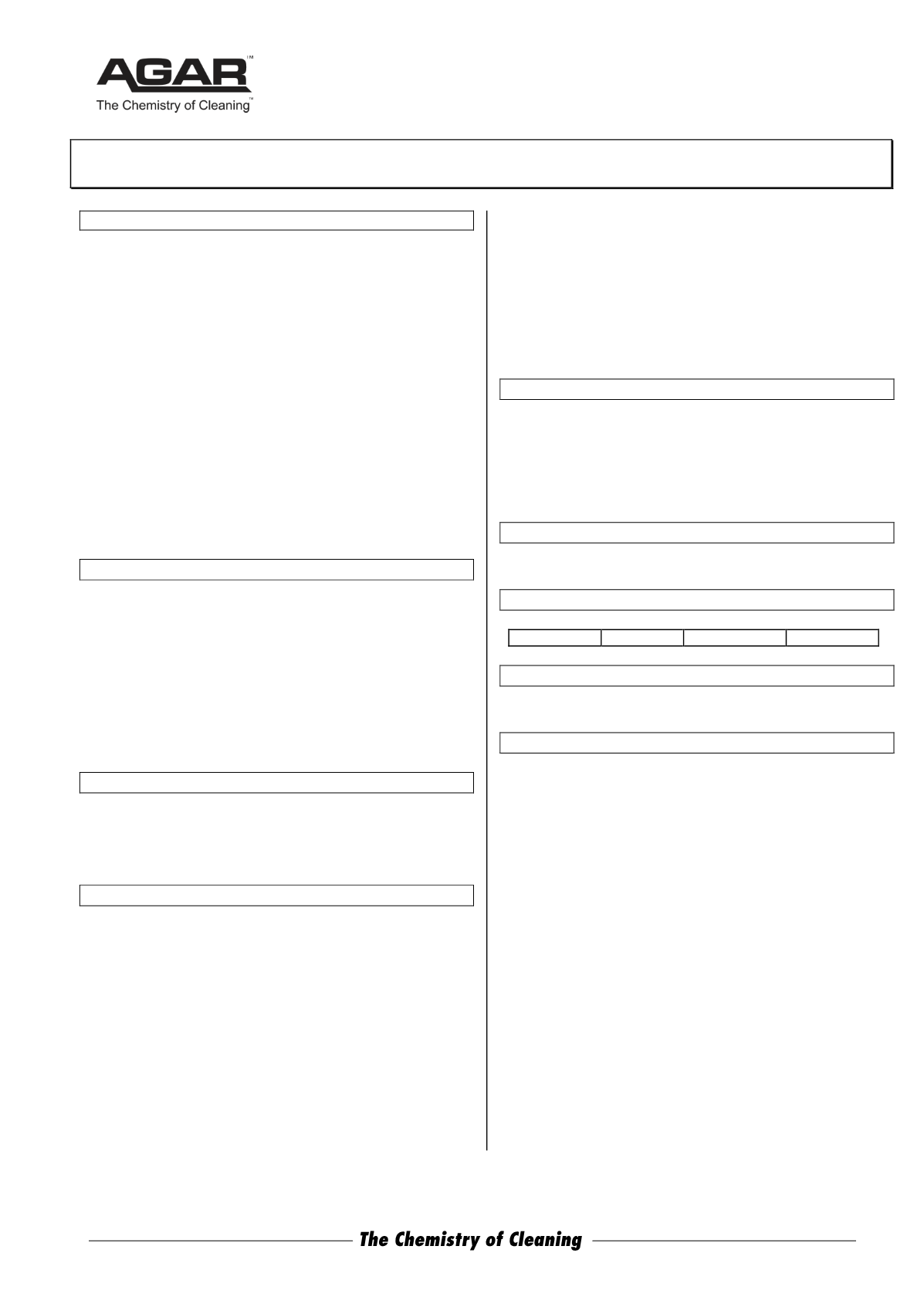

ABN 80 004 726 890 | MADE IN AUSTRALIA
Safety Data Sheet
Issued: January 13, 2012
Page 2 of 3
SD-37
8 EXPOSURE CONTROLS / PERSONAL PROTECTION
Exposure Standards: None assigned for mixture. Data for
principal ingredients only:
Atmospheric Contaminant Exposure Standard for:
2-butoxy ethanol TWA 25 ppm ‘Skin’
Sodium hydroxide : CAS No. 1310-73-2
TWA = - ppm (2 mg/cu.m) Peak limitation
STEL = -
[Source: Safe Work Australia HSIS 2012]
Engineering Controls: Mechanical Ventilation: Not required.
Personal Protection:
Gloves – Impervious natural rubber, butyl rubber, nitrile or
PVC gloves should be worn.
Note: Resistance of glove materials can vary. Evaluate
resistance under conditions of use and maintain PPE
carefully.
Eye-protection - Suitable eye/face protection should be worn.
Other - Protective overalls and boots are desirable.
9 PHYSICAL AND CHEMICAL PROPERTIES
Appearance: Transparent fluorescent red-orange liquid
Odour: Lemon odour
pH = 12 - 13
Vapour Pressure: N/K
Vapour Density: N/K
Boiling Point: 100
°
C
Freezing Point: < 0ºC
Solubility in water: Infinitely miscible
Specific Gravity: 1.03
Evaporation rate: As water
% Volatile by vol: 80 – 90%
10 STABILITY AND REACTIVITY
Stable.
Do not store in aluminium or galvanised containers.
Hazardous polymerization: None.
11 TOXICOLOGICAL INFORMATION
Health Effects:
Acute -
Swallowed: Irritating to the gastro-intestinal tract if swallowed.
Eye: Irritating to the eyes.
Skin: Principal route of exposure is usually by skin contact. One
component may be absorbed by the skin and is capable of
causing skin reactions. Irritating to the skin.
Inhalation: Risk is low if product is used as directed, but
breathing of concentrated vapour should be avoided.
Symptoms of excessive inhalation include irritation of mucous
membranes and respiratory system, headache and nausea.
Avoid generating a mist which may cause coughing.
Health Effects:
Chronic -
Repeated or prolonged skin contact
may cause burns, swelling, blistering or dermatitis.
Toxicity data: Not available for mixture.
2-butoxy ethanol: Acute oral (rat) LD50: 1480 mg/kg.
Inhalation (LC50) (mouse): 700 ppm/7hrs.
Sodium metasilicate: oral (rat) LD50: 1153 mg/kg.
Sodium hydroxide: oral lowest lethal dose (rabbit):-
500 mg/kg (10% solution).
(Note: this data is from published information. Agar Cleaning
Systems does not carry out animal tests).
12 ECOLOGICAL INFORMATION
Ecotoxicity: No data available.
Persistence and degradability: All surfactants in SD-37 are
biodegradable.
Mobility: -
Advice: -
13 DISPOSAL CONSIDERATIONS
For disposal, refer to State Land Waste Management authority.
14 TRANSPORT INFORMATION
UN No.: -
Class: -
Packg.Group: - Hazchem: -
15 REGULATORY INFORMATION
Poisons Schedule Number: Schedule 5.
16 OTHER INFORMATION
AICS Listing:
All components of SD-37 are listed on the
Australian Inventory of Chemical Substances (AICS).
Date: This SDS issued: January 13, 2012
Abbreviations and Definitions of terms used:
<
less than
>
greater than
AICS
Australian Inventory of Chemical Substances
CAS
Chemical Abstracts Service (Registry Number)
COD Chemical Oxygen Demand
deg C Degrees Celsius
g
gram
g/L grams per litre
HSIS
Hazardous Substance Information System
kg
kilogram
L
Litre
LC50
The concentration of a material (inhaled) that
will be lethal to 50% of the test animals.
LD50
The dose (swallowed all at once) which is
lethal to 50% of a group of test animals.
m3
Cubic metre
mg
milligram
Please turn to page 3.


















